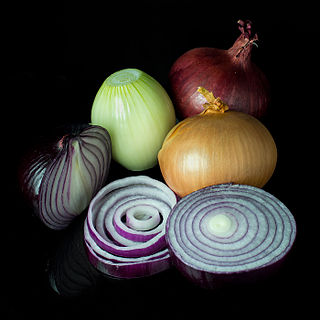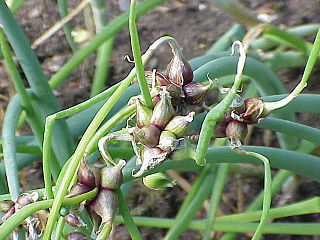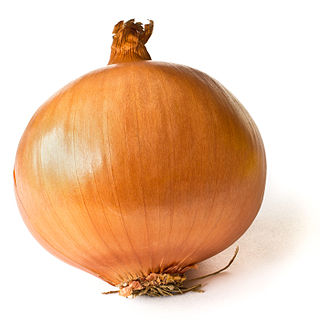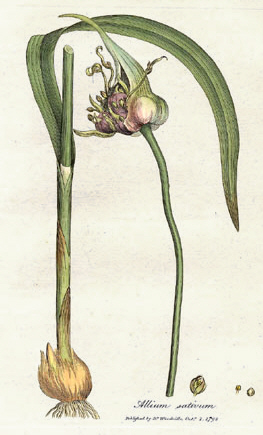
The shallot is a cultivar group of the onion. Until 2010, the shallot was classified as a separate species, Allium ascalonicum. The taxon was synonymized with Allium cepa in 2010, as the difference was too small to justify a separate species.

An onion, also known as the bulb onion or common onion, is a vegetable that is the most widely cultivated species of the genus Allium. The shallot is a botanical variety of the onion which was classified as a separate species until 2011. Its close relatives include garlic, scallion, leek, and chive.

Scallions are edible vegetables of various species in the genus Allium. Scallions generally have a milder taste than most onions. Their close relatives include garlic, shallots, leeks, chives, and Chinese onions.

The tree onion is a perennial plant similar to the common onion (A. cepa), but with a cluster of bulblets where a normal onion would have flowers. Tree onions are also known as topsetting onions, walking onions, or Egyptian onions. Genomic evidence has conclusively shown that they are a diploid hybrid of the shallot and the Welsh onion (A. fistulosum). However, some sources may still treat the tree onion as A. cepa var. proliferum or A. cepa Proliferum Group.

Quercetin is a plant flavonol from the flavonoid group of polyphenols. It is found in many fruits, vegetables, leaves, seeds, and grains; capers, red onions, and kale are common foods containing appreciable amounts of it. It has a bitter flavor and is used as an ingredient in dietary supplements, beverages, and foods.
The management of hair loss, includes prevention and treatment of alopecia, baldness, and hair thinning, and regrowth of hair.
Tetrahydrothiophene is an organosulfur compound with the formula (CH2)4S. The molecule consists of a five-membered saturated ring with four methylene groups and a sulfur atom. It is the saturated analog of thiophene or the sulfur analog of THF. It is a volatile, colorless liquid with an intensely unpleasant odor. It is also known as thiophane, thiolane, or THT.

The yellow onion or brown onion is a variety of dry onion with a strong flavour. They have a greenish-white, light yellow, or white inside; its layers of papery skin have a yellow-brown or pale golden colour.

syn-Propanethial S-oxide (or (Z)-propanethial S-oxide), a member of a class of organosulfur compounds known as thiocarbonyl S-oxides (formerly "sulfines"), is a volatile liquid that acts as a lachrymatory agent (triggers tearing and stinging on contact with the eyes). The chemical is released from onions, Allium cepa, as they are sliced. The release is due to the breaking open of the onion cells and their releasing enzymes called alliinases, which then break down amino acid sulfoxides, generating sulfenic acids. A specific sulfenic acid, 1-propenesulfenic acid, formed when onions are cut, is rapidly rearranged by a second enzyme, called the lachrymatory factor synthase or LFS, giving syn-propanethial S-oxide. The gas diffuses through the air and, on contact with the eye, it stimulates sensory neurons creating a stinging, painful sensation. Tears are released from the tear glands to dilute and flush out the irritant. A structurally related lachrymatory compound, syn-butanethial S-oxide, C4H8OS, has been found in another genus Allium plant, Allium siculum.

Dithietanes are saturated heterocyclic compounds that contain two divalent sulfur atoms and two sp3-hybridized carbon centers. Two isomers are possible for this class of organosulfur compounds:

Protocatechuic acid (PCA) is a dihydroxybenzoic acid, a type of phenolic acid. It is a major metabolite of antioxidant polyphenols found in green tea. It has mixed effects on normal and cancer cells in in vitro and in vivo studies.

Isorhamnetin is an O-methylated flavon-ol from the class of flavonoids. A common food source of this 3'-methoxylated derivative of quercetin and its glucoside conjugates are pungent yellow or red onions, in which it is a minor pigment, quercetin-3,4'-diglucoside and quercetin-4'-glucoside and the aglycone quercetin being the major pigments. Pears, olive oil, wine and tomato sauce are rich in isorhamnetin. Almond skin is a rich source of isorhamnetin-3-O-rutinoside and isorhamnetin-3-O-glucoside, in some cultivars they comprise 75% of the polyphenol content, the total of which can exceed 10 mg/100 gram almond. Others sources include the spice, herbal medicinal and psychoactive Mexican tarragon (Tagetes lucida), which is described as accumulating isorhamnetin and its 7-O-glucoside derivate. Nopal is also a good source of isorhamnetin, which can be extracted by supercritical fluid extraction assisted by enzymes.

Spiraeoside is a chemical compound. It can be isolated from flowers of Filipendula ulmaria (L.) or from the garden onion.

Taxifolin (5,7,3',4'-flavan-on-ol), also known as dihydroquercetin, belongs to the subclass flavanonols in the flavonoids, which in turn is a class of polyphenols. It is extracted from plants such as Siberian larch and milk thistle.

Allium is a genus of monocotyledonous flowering plants with hundreds of species, including the cultivated onion, garlic, scallion, shallot, leek, and chives. The generic name Allium is the Latin word for garlic, and the type species for the genus is Allium sativum which means "cultivated garlic".
The precise taxonomy of the genus Allium is still poorly understood with incorrect descriptions being widespread. With over 850 species distributed over the Northern hemisphere Allium is the sole genus in the Allieae, one of four tribes of subfamily Allioideae (Amaryllidaceae). New species continue to be described and Allium is both highly variable and one of the largest monocotyledonous genera, but the precise taxonomy of Allium is poorly understood, with incorrect descriptions being widespread. The difficulties arise from the fact that the genus displays considerable polymorphism and has adapted to a wide variety of habitats. Furthermore, traditional classications had been based on homoplasious characteristics. However, the genus has been shown to be monophyletic, containing three major clades, although some proposed subgenera are not. Some progress is being made using molecular phylogenetic methods, and the internal transcribed spacer (ITS) region, including the 5.8S rDNA and the two spacers ITS1 and ITS2, is one of the more commonly used markers in the study of the differentiation of the Allium species.

Eric Block is an American chemist whose research has focused on the chemistry of organosulfur and organoselenium compounds, Allium chemistry, and the chemistry of olfaction. As of 2018, he is Distinguished Professor of Chemistry Emeritus at the University at Albany, SUNY.
Leek yellow stripe virus (LYSV) belongs to the genus Potyvirus. It was first detected in leek but also infects garlic and onion worldwide. Economically less important Allium spp., such as Allium angulosum, Allium caeruleum, Allium cyathophorum, Allium nutans, Allium scorodoprasum, Allium senescens subsp. montanum were also found to harbor the virus.
Shallot latent virus (SLV), a species of Carlavirus, was first identified in shallots in Netherlands. The virus particle is elongated, 650 nm in length.














